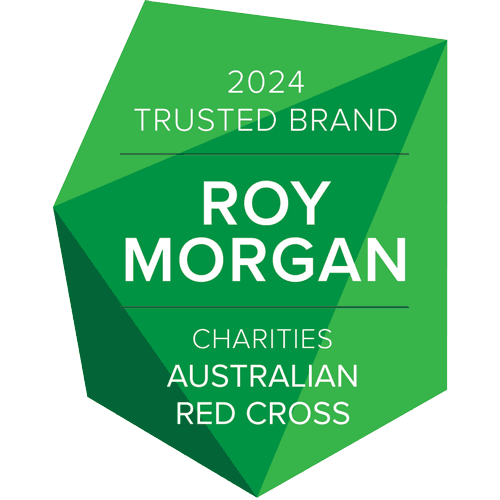The power and spirit of First Nations knowledge
An unfinished story of reconciliation.

Australian Red Cross First Nations knowledge circle participants alongside the Healing Foundation holding the ‘Knowledge’ canvas.
Across the country, First Nations leaders have recently come together to share their knowledge on how Australian Red Cross can build its diversity and inclusion with the true spirit of reconciliation.
Through the traditional First Nations concept of yarning, Aboriginal and Torres Strait Islander Red Cross staff came together to share their perspectives on how Red Cross can improve its diversity and inclusion through knowledge circles set up across Australia.
This initiative, led by Jenny Brown, a Wandi Wandian woman and Head of Aboriginal and Torres Strait Islander Strategy and Impact at Red Cross, in partnership with the Healing Foundation, led to an immense effort spanning two years.
Their vision was to build an understanding of the obstacles and opportunities to improve diversity and inclusion at Red Cross from a First Nations perspective. Most importantly, it was to identify how Red Cross can harness the knowledge and expertise of First Nations staff, so that the organisation can walk respectfully alongside First Nations people.
The gift of knowledge
Knowledge circles are founded on the values that everybody is equal, that everybody should be respected, and that everybody should have the right to speak and be heard. As the knowledge circles began to form, Red Cross and the Healing Foundation decided that recording it on canvas in art form, could be a gift from First Nations staff to Red Cross.
“The discussion basically went: Why don’t we put it on canvas? Why don’t we make something last forever with this? We thought this would be an amazing gift for us, as First Nations staff, to give to Red Cross – sharing our stories, our totems, and knowledge through art on canvas,” said Lee Prouse, a proud Palawa man who is a part of the First Nations Leadership Team.

A close-up of the ‘Knowledge’ canvas. The artwork began in the first knowledge circle from the middle and branched out as it travelled across the vast country.
To ensure as many people could be represented, the team and the canvas’ journey spanned across many Countries. It began in Naarm (Melbourne), Ngambri/ Ngunnawal (Canberra), Thul Garri Waja/ Gurrumbilbarra (Townsville), Larrakia (Darwin), resting along the way on Awabakal (Hunter region, New South Wales), and Nipaluna (Hobart).
For Jenny and Lee, seeing the canvas develop over time was an immense privilege and honour. “The spirit of each knowledge circle is captured in art form on canvas, travelling through traditional countries and lands. There were totems, song lines, stories of Country, and it was very much a co-creation and centrepiece of the knowledge circles. Colleagues placed parts of themselves into artform – footprints, fingerprints, and handprints – capturing the humour and their character,” said Jenny.
Through the knowledge circles, the canvas became a form of expression and healing between many First Nations staff and Red Cross. Lee felt the responsibility of their work, as he travelled with the canvas: “To know that you’re carrying people’s stories from across the country, it was an amazing experience.” Throughout the knowledge circles, Lee authored a poem, ‘Knowledge’, as a way of capturing his thoughts, feelings and intention of the knowledge circles to Red Cross.
Knowledge
Our knowledge did not come from a college
Our knowledge did not come fast
Our knowledge came from many thousands of years past
When we sit in the circle, we bring with us
Story, intellect, and knowledge
The circle is not a college just the incredible power of knowledge
We gather to learn
We gather to educate and share
We bring to you our story
Handed down from those who walked before and left a legacy to behold
Their spirit is with us always – their stories need to be told
Today we give you all a gift – painted on canvas - our totems - songlines and story
Look at it and understand – what you see is knowledge from the First People of this great land
Listen carefully for we are the knowledge holders
We are strong, proud, and resilient – we have stood the test of time
Walk with us as equals and you will see how we lead and shine
As you walk this fine land tread lightly – you walk in the footsteps of those who have been here for many thousands of years
— by Lee Prouse
An unfinished story
The journey of Australian Red Cross towards diversity, inclusion, and reconciliation is an unfinished story.
“We’ve built a platform, but it’s just a platform. We really have to build and construct the dwelling around it, build the walls, and it doesn’t need a roof – it can keep building up, like a skyscraper. We need to continue this energy, not only from our leadership, but also First Nations staff. It’s a two-way street, we have to be committed to it as well,” said Lee.
Jenny and Lee’s vision shared throughout the First Nations Leadership team, hopes to see Red Cross seamlessly embed First Nations culture into its workplace culture, practices, and operations. For Lee, he believes respect, a willingness to embrace local First Nations cultures, and a thirst for knowledge and understanding are the right approaches for everybody to work towards reconciliation.
“It’s a work in progress if we all have a fair dinkum crack at it,” said Lee.
